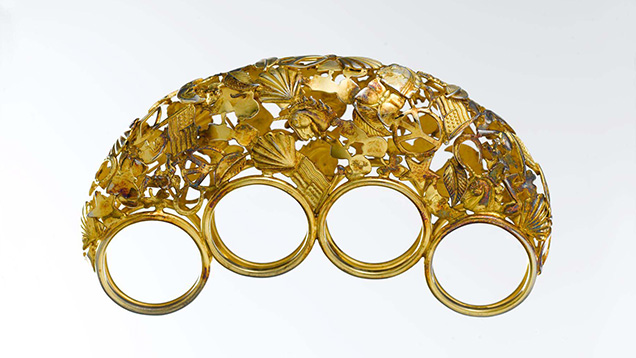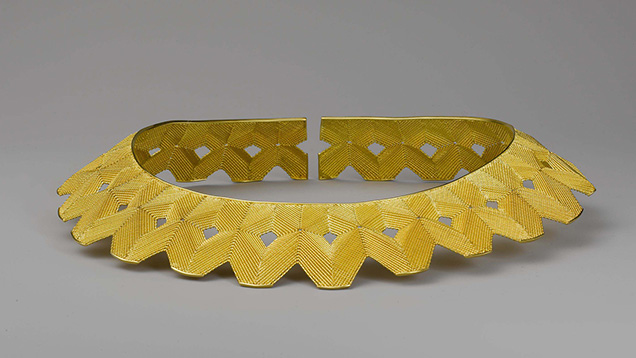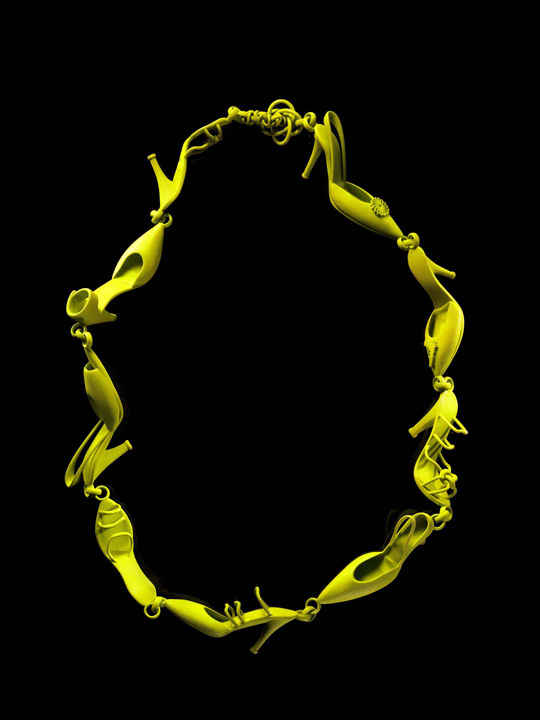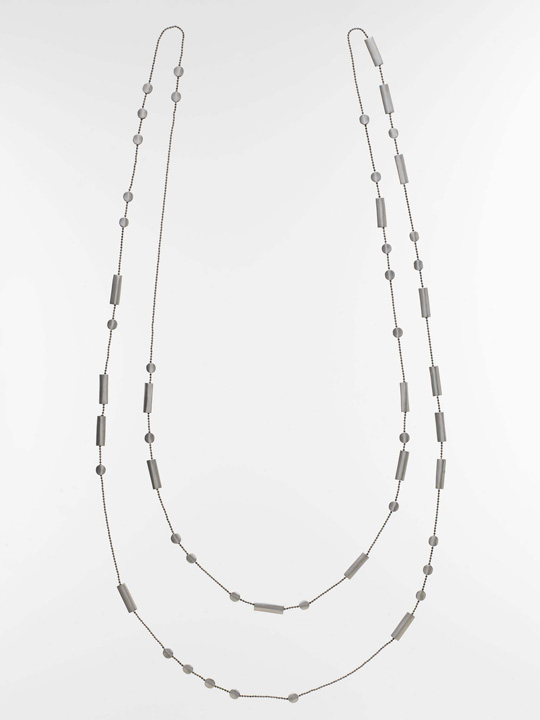Exhibition Review: Unique by Design at the Metropolitan Museum of Art
August 15, 2014

Schneier’s collection documents the evolution of the studio art movement at a time of intense and diverse experimentation. The exhibition comprises many seminal art jewelry pieces, dating from the 1960s through the present, some of which are prominent in contemporary jewelry art books and well deserving of such display at the Met. The following are particularly worthy of mention: a silver, yellow gold, enamel, mother-of-pearl, ebony, and semi-precious gemstone necklace by Earl Pardon; a paper cord and canvas bib necklace and bracelet suite by Eugene and Hiroko Pijanowski; a diamond and PVC-laminated photograph brooch by Gijs Bakker; and a yellow gold, bezel-set emerald, chrysoprase, sapphire, lapis, and enamel square brooch by Hermann Junger.
Images from Unique by Design: Contemporary Jewelry in the Donna Schneier Collection
The exhibit’s museography is simple. The show is hosted in a square room, with the work of three artists highlighted on the back wall: David Watkins's minimalistic silver, steel, and acrylic geometric pieces; William Harper's gold, gemstone, and cloisonné enamel virtuosic numbers; and Thomas Gentille’s oversized eggshell, wood, and lacquer creations. The rest of the exhibit is split between seven themed vitrines, each allowing the visitor to observe objects from the front and the back.The first window is dedicated to the Eugene and Hiroko Pijanowski suite. The second window presents a few selected “Gold” pieces. One of the most notable is the Mary Lee Hu Choker # 70, a magnificent woven necklace which assembles 20 kite-shaped motifs. With these magnificent gold pieces, the exhibition starts with strong, prominent jewelry. The third window's theme, revolving around “Minimalism,” includes the aforementioned diamond brooch by Gijs Bakker and a delicate translucent acrylic cuff bracelet by Emily Van Lersum. Of utmost interest for the gemologist is a silver and mica chain by Joan Parcher. This chain, made of pierced circular mica links, remains a lapidary enigma: How to carve mica, one of the most fragile gem materials? This fascinating display revisits the perception of value by using non-precious material, demonstrating that craftsmanship and design may be more important than the value of the material used.
The fourth group challenges the usual notion of scale displays “Maximal” pieces. One of the most impressive examples featured is an oversized silver, yellow gold, and garnet heart brooch by Lola Brooks. The fifth vitrine assembles jewels with a “Narrative” quality. The most striking, a breastplate by Kiff Slemmons made of silver, No. 2 pencils, stone, horsehair, coins, and leather, is reminiscent of a Native American trophy neckpiece. The sixth column is filled with “Found and Parodied Objects.” One of the most illustrative items in this ensemble is a gold-plated silver, plastic polymer, and found-objects necklace by Helen Britton. The last vitrine presents “Sculptural” jewelry. This extremely diverse group, comprised mainly of brooches, clearly highlights a parallel between sculpture, architecture, and jewelry. Georg Dobler's steel wire and black chrome geometric lattice brooch provides an emblematic example.
For jewelry enthusiasts, students, and modern art amateurs, the Schneier collection is a must-see exhibition that displays the endless variety of art studio jewelry. The impressive collection would certainly have benefited from a more detailed and didactic museography to help the visitor appreciate the originality and quality of the items displayed. Who better than the Met could draw enlightening parallels between the antique, Viennese School, and Art Deco inspirations? One could only lament that jewelry exhibitions in general provide little explanation on how these works of art are inspired and produced. The magnificence and significance of this ensemble may not be fully appreciated, as the visitor leaves the Met with no documentation related to the show. Jewelry collections, even contemporary ones, require more historical and cultural background materials to convert art amateurs into avid jewelry collectors.
ABOUT THE REVIEWER
Delphine Leblanc is a valuation specialist at Tiffany & Co. in New York City.













